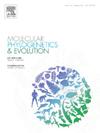Phylogeny of Palicoureeae (Rubiaceae) based on 353 low-copy nuclear genes – with particular focus on Hymenocoleus Robbr.
IF 3.6
1区 生物学
Q2 BIOCHEMISTRY & MOLECULAR BIOLOGY
引用次数: 0
Abstract
Members of the tribe Palicoureeae of the coffee family (Rubiaceae) have a complex taxonomic history and have been the focus of few modern systematic studies. The tribe comprises about 1,100 tropical species in ten genera. To investigate phylogeny, we used a target capture approach and the angiosperm-wide Angiosperms353 bait set to produce genomic data for a representative taxon sample of Palicoureeae, with particular focus on the African genus Hymenocoleus. Using coalescent-based inference methods, we find that Puffia gerrardii (recently separated from Geophila) is sister to Hymenocoleus. The deepest split in Hymenocoleus is highly affected by incomplete lineage sorting, possibly as a consequence of rapid speciation during the early evolution of the clade. Remaining interspecific relationships in Hymenocoleus could be confidently resolved and while Robbrecht’s traditional infrageneric classification scheme based on floral features is not supported as reflecting evolution in the group, we find that several other features do, e.g. characters of pyrenes and involucral cups. Although not free of challenges, a strong advantage with our analytical approach is that gene tree heterogeneity can be taken into account. Including flanking regions yielded data sets that had the strongest power to reject polytomies and produced less gene tree error, resulting in species trees with higher normalised quartet scores and higher average support compared to trees inferred only from exon data. Presumably paralogous loci are often filtered out prior to species tree estimation but we find that they may contribute important phylogenetic information when using an inference method that actively accounts for them.

基于353个低拷贝核基因的茜草科植物系统发育——以膜球菌为例。
咖啡科(Rubiaceae)的Palicoureeae部落成员具有复杂的分类历史,并且已经成为少数现代系统研究的焦点。该部落包括10个属的1100个热带物种。为了研究系统发育,我们采用目标捕获方法和全被子植物Angiosperms353诱饵集对Palicoureeae的代表性分类群样本进行了基因组数据采集,特别是对非洲属Hymenocoleus进行了研究。利用聚结推理方法,我们发现最近从地蚜中分离出来的盖氏蝶属(Puffia gerrardii)是Hymenocoleus的姊妹种。膜孔虫中最深的分裂高度受谱系分选不完整的影响,这可能是该支系早期进化过程中快速物种形成的结果。虽然Robbrecht传统的基于花特征的亚属分类方案不能反映该类群的进化,但我们发现其他一些特征可以反映该类群的进化,例如pyrenes和总苞杯的特征。虽然不是没有挑战,但我们的分析方法的一个强大优势是可以考虑基因树的异质性。包括侧翼区域产生的数据集具有最强的拒绝多截和产生更少的基因树错误的能力,导致物种树与仅从外显子数据推断的树相比具有更高的标准化四重奏得分和更高的平均支持度。在物种树估计之前,通常会过滤掉类似的基因座,但我们发现,当使用积极考虑它们的推理方法时,它们可能会提供重要的系统发育信息。
本文章由计算机程序翻译,如有差异,请以英文原文为准。
求助全文
约1分钟内获得全文
求助全文
来源期刊
CiteScore
7.50
自引率
7.30%
发文量
249
审稿时长
7.5 months
期刊介绍:
Molecular Phylogenetics and Evolution is dedicated to bringing Darwin''s dream within grasp - to "have fairly true genealogical trees of each great kingdom of Nature." The journal provides a forum for molecular studies that advance our understanding of phylogeny and evolution, further the development of phylogenetically more accurate taxonomic classifications, and ultimately bring a unified classification for all the ramifying lines of life. Phylogeographic studies will be considered for publication if they offer EXCEPTIONAL theoretical or empirical advances.

 求助内容:
求助内容: 应助结果提醒方式:
应助结果提醒方式:


